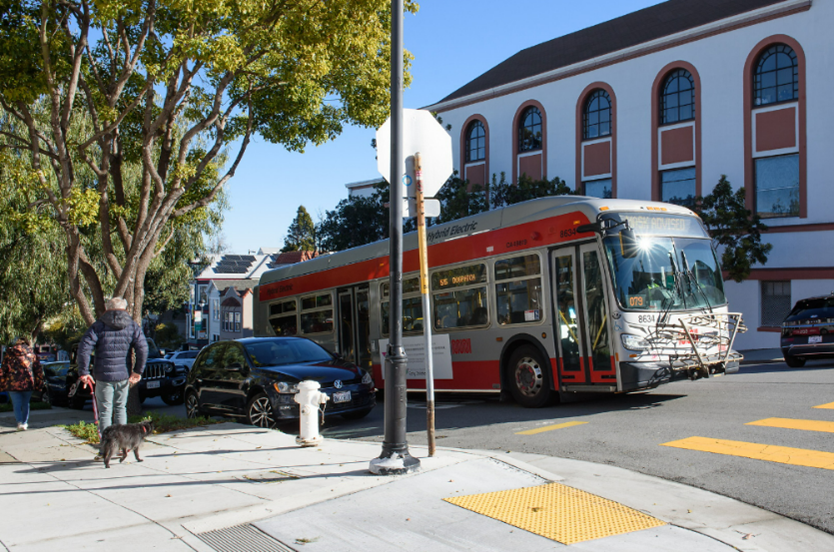San Francisco has 3,500 Muni stops, including about 1,200 stops at which there isn’t enough space for the bus to pull to the curb for riders to board. Instead, Muni buses stop in the travel lane, and riders often must walk in between parked cars to get on and off. These stops are called “flag stops.”
Why convert Flag Stops?
- Accessibility: Without access to the curb, buses are not able to deploy wheelchair lifts or lower the vehicle closer to the curb to reduce the boarding distance. This results in riders not being able to use that stop.
- Safety: Muni riders boarding at flag stops may go between parked cars or enter the travel lane to get on the bus. When they do, they are at risk of collisions with drivers in the parking and travel lanes as well as those bicycling and otherwise traveling in the roadway.
- Transit speed and service: Buses may need extra time at flag stops waiting for passengers to walk from the curb to the bus to board, which causes delays for everyone. Additionally, with parked vehicles between the bus and the curb, bus operators may not see passengers waiting to board. buses may need extra time at these stops waiting for passengers to walk from the curb to the bus to board, which delays the bus for everyone.
When the SFMTA converts a flag stop, we paint a 20-foot red curb “clear zone” where the Muni stop is located. Twenty feet is enough space to provide improved access to the front door of the bus and is about the size of one parking spot.
While this parking loss may raise concerns, there are many competing interests vying for the limited curb space in San Francisco. Currently, 90% of San Francisco's curb space is allocated to parking. Only 1% of curb space is dedicated to transit boardings or accommodating pick-ups/drop-offs and shared mobility services. You can find more information about how the SFMTA manages curb space in our Curb Management Strategy.
- Current
At this flag stop, the bus stops in the travel lane, and cars are parked between the bus and the curb. Riders must walk in the travel lane and around the parked cars to get on or off the bus.
Project Background
The San Francisco Board of Supervisors unanimously passed a resolution calling for SFMTA to upgrade these stops and “promote unobstructed pedestrian access for boarding public transit by eliminating parking in bus stops” In November 2021.
To comply with the Board of Supervisors resolution, the SFMTA Board of Directors approved adding this language to the bus stop guidelines at its December 13, 2022, meeting:
“Each stop in the system should have at least a 20’ red curb to provide unobstructed access to the front door of a bus or train. When applicable, SFMTA Accessible Services shall request, and prioritize, locations for front door transit bulbs that have a pattern of boarding by wheelchair users, other disabled persons or seniors.”
Phase One: Beginning March 2023
In phase one, SFMTA will implement 20-foot red curb “clear zones” at all Muni flag stops that come right before an intersection. These are known as “near-side” bus stops. There are approximately 900 near-side Muni flag stops to analyze for this type of conversion. We anticipate analyzing 50-75 flag stops a month.
We plan to paint 20-foot curb “clear zones” in order of the type of flag stop:
- Flag stops on citywide accessibility routes identified in the Muni Service Equity Strategy would be painted first. These routes are heavily used by seniors and people with disabilities and include the 8 Bayshore, 9 San Bruno and 9R San Bruno Rapid, 14 Mission and 14R Mission Rapid, 30 Stockton, 31 Balboa, 38 Geary and 49 Van Ness/Mission.
- Flag stops on Muni’s remaining Rapid and frequent routes (10 minutes service or less) would be painted second.
- The remaining near-side flag stops that are not along accessibility routes, rapid routes or frequent routes would be painted third.
Phase Two: Expected Mid-2024
In phase two, we'll paint red curb “clear zones” and remove parking at the remaining flag stops. There are about 300 flag stops that are after the intersection (on the far side of the street) or in the middle of the block. These stops may require changes beyond a 20-foot red clear zone, which takes more time and includes additional outreach. In phase two, we’ll also continue to evaluate further improvements at the stops from phase one.
Our priorities during phase two will be:
- Stops with rider complaints about lack of access and requests for stop upgrades that improve access
- Commercial areas
- Stops with existing transit shelters
Project Outreach
In advance of converting flag stops on a Muni route, we will share updates by posting notices near stops and as-needed canvassing to the immediate area.
If you would like for us to prioritize a particular bus stop for conversion, please make a request through 311 and we will take that into account whenever possible.

